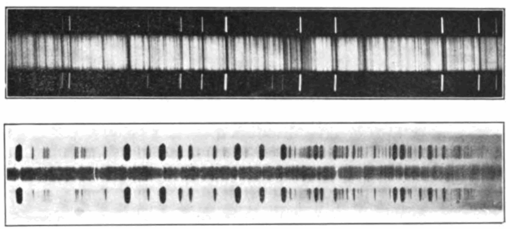the true rotation period. This means that they would have shown Venus's to within 14 minutes if the conditions were as good. As Jupiter's spectrograms are easier to measure than Venus's, while Mars's are more difficult, we may take 25 minutes for the mean of the two criteria. I need perhaps not tell you that no previous spectrograms of Jupiter for rotation had come up to this precision.
From these two determinations on Jupiter and Mars we may determine the utmost period of rotation for Venus which the spectroscope could disclose. This would be the period for which the probable error was just equal to the quantity to be measured. From Mars we have for a 24-hour period on Venus a probable error of 31 minutes. This is one forty-eighth of the quantity measured on the supposition of a day's period. One of 48 days, therefore, would have its probable error equal to the quantity itself. From Jupiter we get in the same way 96 days. Thus from two to three months would be the limit of leisureliness the spectroscope could be got to note, and it was just this quantity that the investigations on Venus themselves expressed.
The spectroscope, therefore, definitely asserts that the rotation of Venus does not take place in anything approaching twenty-four hours, and by negativing any period up to two or three months long corroborates to the limit of its ability that shown by eye observation, one of 225 days.
The care at Flagstaff with which the possibility of error was sought to be excluded in this investigation of the length of Venus's day and the concordant precision in the results are worthy of notice. For it is by thus being particular and systematic that the accuracy of the determinations made there in other lines besides this has been secured.
Now a certain peculiarity of Venus's appearance of a totally different kind from those so far spoken of, here comes in to corroborate both of the previous determinations: the perfect roundness of her figure. For this very rondure has something to disclose. If Venus rotated in anything like twenty-four hours her disk should be perceptibly flattened at the poles, her figure becoming squat in consequence of her spin. For though as rigid as steel to sudden impulses she would be like putty at

